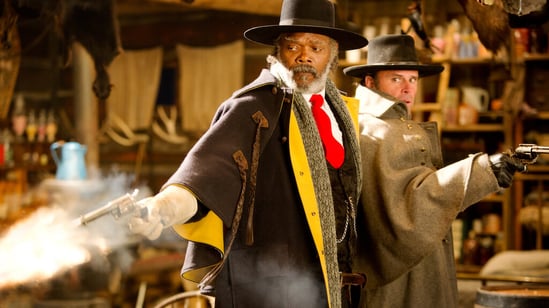The Hateful Eight: A Chilling Symphony of Deceit and Survival
Cinemapedia
Quentin Tarantino’s The Hateful Eight is a masterclass in tension, deception, and the darker corners of human nature. Released in 2015, this Western mystery-thriller unfolds like a stage play, confining its characters within the claustrophobic walls of Minnie’s Haberdashery as a brutal blizzard rages outside. With its razor-sharp dialogue, intricate plotting, and an ensemble cast delivering powerhouse performances, The Hateful Eight explores themes of trust, betrayal, and survival in a world steeped in moral ambiguity.
Strangers in a Snowstorm
Set several years after the Civil War, the story begins with bounty hunter John "The Hangman" Ruth (Kurt Russell) transporting his fugitive prisoner, Daisy Domergue (Jennifer Jason Leigh), to Red Rock to face justice. Along the way, they encounter Major Marquis Warren (Samuel L. Jackson), a former Union officer turned bounty hunter, and Chris Mannix (Walton Goggins), a self-proclaimed sheriff of dubious credentials.
Seeking shelter from a blizzard, the group arrives at Minnie’s Haberdashery, where they meet four more strangers: Bob (Demián Bichir), who claims to be running the establishment in Minnie’s absence; Oswaldo Mobray (Tim Roth), a genteel executioner; Joe Gage (Michael Madsen), a taciturn cowboy; and General Sandy Smithers (Bruce Dern), a former Confederate officer. As tensions rise and alliances shift, it becomes clear that not everyone is who they claim to be, setting the stage for a deadly game of survival.
A Snowbound Stage
Shot in stunning 70mm film, The Hateful Eight is a visual feast that juxtaposes the expansive beauty of snow-covered landscapes with the oppressive intimacy of the haberdashery’s interiors. Cinematographer Robert Richardson uses wide shots to capture the desolation of the Wyoming wilderness, while close-ups and tight framing heighten the claustrophobia and paranoia within the cabin.
The production design is meticulously detailed, with every object and piece of furniture contributing to the film’s rich atmosphere. The use of lighting—from the warm glow of oil lamps to the stark whiteness of the snow—further enhances the mood, creating a sense of isolation and unease.
Ennio Morricone’s Haunting Score
The late Ennio Morricone’s Oscar-winning score for The Hateful Eight is a haunting and evocative masterpiece that amplifies the film’s tension and drama. From the ominous opening overture to the chilling motifs that punctuate key moments, Morricone’s music serves as an integral part of the storytelling.
In addition to the original score, Tarantino incorporates carefully chosen songs and sound effects, including Roy Orbison’s "There Won’t Be Many Coming Home," which underscores the film’s themes of isolation and inevitable reckoning.
Justice, Vengeance, and the Human Condition
At its core, The Hateful Eight is a meditation on the fragility of trust and the complexities of justice. Each character is driven by their own motives, whether it’s vengeance, survival, or a twisted sense of honor. The film blurs the line between hero and villain, challenging viewers to question their own moral compass as the characters’ true natures are revealed.
Tarantino also delves into the lingering scars of the Civil War, using the characters’ backgrounds and interactions to explore themes of racism, loyalty, and the cost of conflict. The result is a story that is as thought-provoking as it is brutal, forcing audiences to confront uncomfortable truths about human nature.
A Dark and Compelling Chamber Drama
The Hateful Eight is a bold and uncompromising film that showcases Quentin Tarantino’s mastery of dialogue, tension, and character. Its deliberate pacing and intricate narrative structure reward patient viewers, while the exceptional performances—particularly from Samuel L. Jackson, Jennifer Jason Leigh, and Kurt Russell—bring depth and nuance to the story.
With its striking visuals, haunting score, and thought-provoking themes, The Hateful Eight is a chilling symphony of deceit and survival that lingers in the mind long after the credits roll. It is a testament to Tarantino’s ability to craft stories that are as visually stunning as they are emotionally and intellectually engaging.


